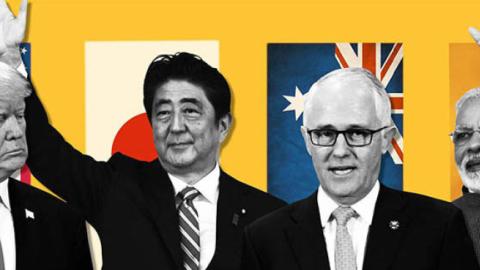In recent months, India has taken several steps to advance its security cooperation with the United States, Japan and Australia. In September 2018, India held productive two-plus-two level meetings (meetings between the foreign and defense ministers and secretaries of both countries) with the United States. Then, in October 2018, India decided to hold additional two-plus-two meetings with Japan. A second secretary-level dialogue was held in November 2018, following the re-initiation of India-U.S.-Japan-Australia Quadrilateral Dialogue in November 2017.
Yet even though India’s recent diplomatic activity indicates that the country is intent on strengthening its relations with the U.S., Japan and Australia, India appears to be much more reluctant to advertise the military dimensions of its cooperation to the wider world. Why is the message that India is sending so complicated? In short, this has to do with one country: China.
India faces a dilemma that differentiates its strategic concerns from those of the U.S., Japan and Australia: India alone among the four countries shares a land border with China. That puts India in a bind as it considers the prospect of military cooperation. Simply put, the more India cooperates with the U.S., Japan and Australia, the more it can improve its ability to counter China in the Indo-China border area. However, the more that the countries cooperate, the more it will have an effect undesirable to India: China will respond by deploying an increasingly greater number of forces to the Chinese side of the India-China border.
India must make a determined effort to resolve this contradiction. India’s cooperation with Japan-U.S.-Australia will be an effective way for India to address long-term issues with China in the Indo-China land border area. There are three reasons why.
Firstly, China’s activities in the Indo-China border area have grown more threatening to India in recent years. China has developed weapons, including tanks that can operate in the mountainous Tibet region, and it has built strategic roads in the area that help China to mobilize on India’s borders. China has also increased the number of its airports from six to 15.
Yet, China’s provocations extend beyond strategic infrastructure projects. In addition, Chinese military forces have become more aggressive. Since 2011, India has recorded between 300 to 500 incursions every year. Apart from this, the frequency of exercises by the Chinese Air Force has increased; China has also deployed troops in Pakistan-occupied Kashmir. It is expected that China’s aggression in the Indo-China border area will only get worse in the coming years, perhaps even in the near future. India must enhance its ability to deter Chinese aggression on its borders, and cooperation with Japan, the US and Australia is an effective way to do it.
To that end, the U.S. already provides a significant supply of defense equipment to India. The 17th Corp of the Indian Army, which India established to manage tensions with China in the Indo-China border area, is an especially good example. The US provides more equipment to the 17th Corp than any other country does. The size of the 17th Corp is currently around 90,000 soldiers, which is a large number, especially in light of the total size of the Indian Army (1.3 million soldiers). By using American-provided transport planes and helicopters, the 17th Corp can conduct air lift offensive operations in the Tibet area. The American-provided military equipment includes transport planes (C-17 and C-130), attack helicopters (AH-64), heavy lift-helicopters (CH-47), and ultra-light howitzers (M777), in addition to other equipment.
The U.S. is not the only country that contributes to India’s defensive capabilities. Japan has also contributed to it by building strategic roads in Northeast India. Even though these roads are outside of Arunachal Pradesh, which China claims as its territory, the Indian Army can use these roads to deploy forces to defend its border with China. Evidently, cooperation with Japan also strengthens India’s defensive capability in the Indo-China border area.
Secondly, China’s recent history of military aggression in the region also indicates that cooperation with the U.S., Japan and Australia will be an effective way to deter Chinese aggression. In the past, China has engaged in maritime expansion at times when geopolitical realignments have created power vacuums for it to fill. It is a pattern that has played out numerous times in the South China Sea in recent decades. For instance, in the 1950s, China occupied half of the Paracel Islands after France withdrew from Vietnam. In 1974, China seized and occupied all of the Paracel Islands, just after the Vietnam War ended and the U.S. withdrew from the region. In 1988, China took the Vietnam-controlled Spratly Islands after the Soviets withdrew from Vietnam. Along similar lines, China invaded the Mischief Reef, which both the Philippines and Vietnam claim as their own, after the U.S. withdrew from the Philippines. Reflecting on the recent history of the South China Sea, it becomes evident that cooperation between India, the U.S., Japan and Australia will maintain a balance of military power that will be decisive for deterring China’s aggression.
An additional advantage to cooperation is that the geographical locations of India and Japan on opposite sides of China can offset the numerical advantage of China’s larger military. In the case of a conflict between China, India and Japan, India would not need to deal with all of China’s fighters at once, because China would need to retain its defensive capabilities in the country’s eastern front in order to protect itself from an attack from Japan, and vice versa. Dividing China’s huge defense resources multi-directionally is a useful way for India, Japan and other countries to maintain the military balance with China.
Thirdly, cooperation between India, the U.S., Japan and Australia is desirable because it has already proven itself to be effective. The Doklam crisis, which occurred from June to August of 2017, was an important test case for India-US-Japanese-Australian cooperation. During the rise in tensions between India and China during the crisis, the United States provided India with valuable information about China’s activities in the border region. It also dispatched an aircraft carrier, and Japan dispatched a helicopter carrier to hold joint exercises in the Indian Ocean during the crisis.
But it wasn’t military support alone that had the effect of turning the outcome of the crisis in India’s favor. In addition, Japanese diplomatic support played a critical role. Japan’s public proclamation in support of India may even have had a hand in ending the crisis, with some analysts suggesting that the threat of closer ties between India and Japan may have encouraged China to de-escalate. They cite as evidence the fact that the Doklam crisis ended just before the then Indian Defense Minister Arun Jaitley’s visit to Japan and Japanese Prime Minister Shinzo Abe’s visit to India. It is thought that China did not wish to encourage increased India-Japan security ties by continuing the border stand-off.
Nonetheless, despite the evident strategic value of cooperation between the four countries in the long run, it looks as if the Indian government is not in a hurry to pursue it. One of the main reasons is that, in the short term, most of China’s forces do not pose a direct threat to India: most are still stationed in China’s east, positioned to counter Japan and countries around the South China Sea. If India can avoid provoking China, it will benefit by not having to defend itself against the brunt of China’s forces. There is another lesson from the Doklam crisis in 2017 that affects India’s attitude toward military cooperation with the US, Japan and Australia. Although cooperation is effective, it does not address all of India’s short-term concerns: American and Japanese military and diplomatic support was not enough to prevent the crisis from happening altogether.
Therefore, India is caught between its long-term and short-term goals: in the near term, India wants to avoid confrontation with China, even though in the long run it will seek cooperation with the U.S., Japan and Australia. The United States, Japan and Australia should exercise patience and appreciate the complexities of India’s efforts to deal with its land-border problem with China, while seeking long-term security cooperation.















